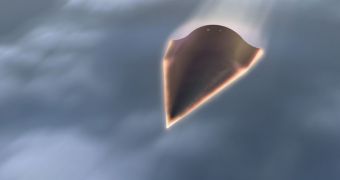A test flight that took place yesterday, August 11, on the western coast of the United States, ended in failure for the US Defense Advanced Research Projects Agency (DARPA). The organization was testing its new hypersonic aircraft prototype, a vehicle built to travel at Mach 20.
If successful, the project could have resulted in the creation of a fleet of such vehicles. However, the Falcon Hypersonic Technology Vehicle 2 (HTV-2) prototype crashed into the Pacific Ocean before completing its primary mission.
This hybrid aircraft was powered by scramjet technology, and was theoretically capable of reaching speeds about 20 times faster than that of sound, or around 13,000 miles per hour. This would have enabled it to travel from New York to Los Angeles in about 12 minutes.
It would have also gave the United States the upper hand in tactical strike strategies, since it would have enabled the delivery of nuclear bombs anywhere in the world within less than an hour.
However, DARPA announced yesterday that a malfunction in the aircraft prevented it from sending information back to the ground, as it was flying around Mach 20. As programmed, the craft put itself on a collision course with the ocean when control was lost.
Launch occurred from the Vandenberg Air Force Base (VAFB), in California, at 7:45 am PDT (1445 GMT). A Minotaur 4 delivery system boosted the Falcon to low-Earth orbit (LEO), from where the craft reentered Earth's atmosphere.
“This transition represents a critical knowledge and control point in maneuvering atmospheric hypersonic flight,” DARPA officials wrote in a statement explaining the loss of HTV-2.
“More than nine minutes of data was collected before an anomaly caused loss of signal. Initial indications are that the aircraft impacted the Pacific Ocean along the planned flight path,” they added.
The US Air Force also reacted to the news. “Here’s what we know. We know how to boost the aircraft to near space. We know how to insert the aircraft into atmospheric hypersonic flight,” said USAF DARPA HTV-2 program manager Air Force Maj. Chris Schulz, who holds a PhD in aerospace engineering.
“We do not yet know how to achieve the desired control during the aerodynamic phase of flight. It’s vexing; I’m confident there is a solution. We have to find it,” the Pentagon official concluded.

 14 DAY TRIAL //
14 DAY TRIAL //